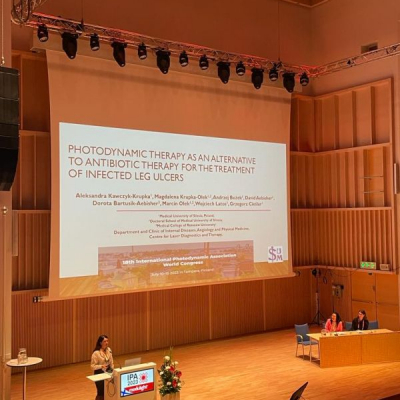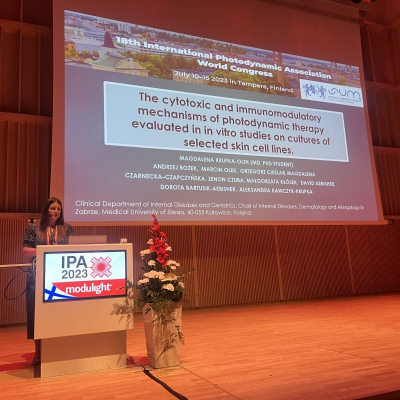On July 10-15, 2023, the IPA World Congress was held in Tampere, Finland, in which employees of the Silesian Medical University Ms. Prof. Aleksandra Kawczyk-Krupka, MD, PhD, and doctoral students of the Doctoral School Dr. Magdalena Krupka-Olek from the Clinical Department of Internal Medicine, Dermatology and Allergology (supervisor Prof. Andrzej Bożek, MD, PhD) and dentist Dr. Marcin Olek from the Department of Orthodontics (supervisor Prof. Agnieszka Machorowska-Pieniążek, MD, PhD). The authors of the papers from the Department of Internal Medicine, Angiology and Physical Medicine and the Center for Diagnostics and Photodynamic Therapy were the Head of the Department, Prof. Grzegorz Cieślar, MD, and Piotr Oleś, MD, and Magdalena Czarnecka-Czapczyńska, MD, PhD student at the Doctoral School (supervisor Prof. A. Kawczyk-Krupka). Procedures for diagnosis and photodynamic therapy of precancerous conditions and cancers of the skin, oral cavity and gastrointestinal tract were presented at the Congress. Photodynamic procedures are also used in antimicrobial treatment and are being applied at the aforementioned Center in a pilot clinical trial for the treatment of lower leg ulcers, the results of which were presented by Prof. Aleksandra Kawczyk-Krupka. All presenters were invited to give plenary speeches.
Photodynamic diagnosis and therapy are recognized as new and non-invasive methods for diagnosis and effective treatment of cancerous lesions. Photodynamic therapy (PDT) is a method of treating selected (primarily early)cancers and precancerous conditions. The essence of this method is the selective destruction of diseased tissues by acting on them with laser light of a strictly defined wavelength. This phenomenon is made possible by a substance - a photosensitizer, captured by the pathologically altered tissue. The standard photosensitizers used are porphyrins, which are a component of hemoglobin. Photodynamic action induces three types of reactions in the irradiated tissue: a direct cytotoxic effect, an indirect cytotoxic effect through occlusion of blood vessels, and a secondary immunostimulatory and pro-inflammatory effect. Of the aforementioned modes of action, the immunostimulatory effect appears to be unique, given that both chemotherapy and radiotherapy cause impairment of immune system function. Many experimental works have shown that during photodynamic therapy there is a mobilization of immunocompetent cells: infiltration of lymphocytes, neutrophils, macrophages, which indicates the activation of the inflammatory process. Mediators of this process are vasoactive substances, complement C3 components, acute phase proteins, proteinases, peroxidases, reactive oxygen species, cytokines, growth factors and other substances involved in the immune response. It is emphasized that the immunomodulatory effect of photodynamic therapy is also associated with effects on angiogenesis and metastatic activity of tumor cells.
Held every two years, the World Congress of the International Photodynamic Society aims to bring together scientists and clinicians from all fields of photodynamic therapy (PDT) and photodiagnostics (PDD) since 1986. The IPA holds the conference every two years to foster scientific development and contribute to the implementation of photodynamic procedures into clinical practice.



